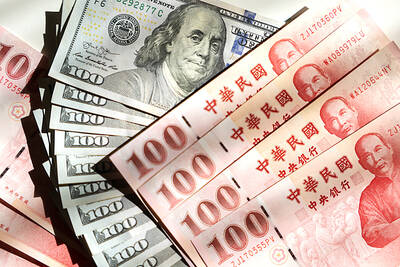Siliconware Precision Industries Co (SPIL, 矽品精密) chairman Bough Lin (林文伯) does not plan to retire from the semiconductor industry, despite losing his grip on the company cofounded by his father more than three decades ago.
In the summer of 1984, SPIL started out as a small factory in a three-story building in a Taichung suburb, financed mainly by Lin Chung-li (林鐘隸), Bough Lin’s father.
SPIL was Taiwan’s first chip tester and packager, at the time competing with Texas Instruments Inc and General Electric Co.
Despite its status as the world’s No. 3 chip tester and packager, with an annual revenue of NT$82.84 billion (US$2.61 billion) and a net profit of NT$8.76 billion last year, SPIL was faced with a takeover bid by its bigger rival, Advanced Semiconductor Engineering Inc (ASE, 日月光半導體), in August last year.
After months of resisting the bid, SPIL in May agreed to merge with ASE into a holding company.
Bough Lin agreed to sell his 2.07 percent stake in SPIL to ASE and is to sit on the board of the new holding company — ASE Industrial Holding Co Ltd (日月光投資控股) — after ASE obtains the approval of global competition watchdogs to complete the NT$128.7 billion deal next year.
In an interview during a business trip to Japan last month, 65-year-old Bough Lin said that Japan is evolving and plays a critical role in the supply of semiconductor components and materials.
“Without Japan, not a single iPhone can be assembled and shipped,” he said.
According to statistics provided by SPIL, half of the components in Apple Inc’s iPhone are sourced from Japan, including memory chips and displays.
Japan supplies 50 percent of the components used by the global semiconductor industry, and the figure rises to 70 percent when it comes to supplying components to chip testers and packagers, SPIL said.
Japan contributed only 1 to 2 percent of SPIL’s total revenue last year, but Bough Lin said he remains optimistic about the market’s long-term prospects.
Chang Jan-jue (張仁治), president of United Microelectronics Corp’s (聯電) Japanese unit, voiced similar views.
While Japanese firms stopped investing in chip manufacturing technologies at the 65-nanometer process, they are potential growth drivers for Taiwan’s semiconductor industry, Chang said.
Last year, Japanese semiconductor companies placed outsourcing orders to Taiwanese firms totaling US$2.5 billion, compared with US$1 billion in 2014.
“We believe this trend will continue,” Chang said.
Niigata, Japan-based Namics Corp has invested more than US$10 million in a factory in Miaoli County’s Tongluo Township (銅鑼), and plans to raise the contribution of advanced semiconductor materials from the plant to 50 percent of overall shipments by the end of this year, Namics Taiwan Co general manager Eric Teng (鄧志華) said.
However, Bough Lin said he is concerned about the prospects of Taiwan’s semiconductor industry amid the rise of China’s semiconductor companies.
He asked what the next growth drivers will be for Taiwanese semiconductor firms, after PC, memory, mobile and TV chips.
“We are losing direction,” Bough Lin said in the interview.
“South Korea is making progress” in drawing up development plans, “and so is China,” he said.
Debates over whether to relax restrictions on Chinese investment in Taiwanese chip companies continue, with a focus on whether Taiwan’s national champions might be absorbed into China’s supply chain.
Bough Lin said that Taiwanese companies need to cope with the rise of China, which is soon to surpass Taiwan to become the world’s No. 2 chip designer.
“China will become the [center of the global] semiconductor market over the next 10 years,” he said, adding that Chinese electronics vendors are using domestically developed chips in their products and have a large domestic market to expand their businesses.
President Tsai Ing-wen’s (蔡英文) administration is forging new policies to reorient Taiwan’s economy toward a more balanced model, but the transition might prove to be challenging.
The government’s “new southbound policy” might not apply to the semiconductor industry, as there are no major chip manufacturing plants or big electronics assemblers in Southeast Asia, Bough Lin said.
“The lack of a cluster effect is the main concern,” he said.
However, he said Taiwan has its own advantages, and can be the world’s chip manufacturing hub.
Taiwan has a high-quality, stable workforce, compared with China’s high labor turnover rate of 8 percent, which translates into more than 10,000 workers being replaced each year, he said.
Wages in China have also climbed steadily in recent years, he added.

MARKET LEADERSHIP: Investors are flocking to Nvidia, drawn by the company’s long-term fundamntals, dominant position in the AI sector, and pricing and margin power Two years after Nvidia Corp made history by becoming the first chipmaker to achieve a US$1 trillion market capitalization, an even more remarkable milestone is within its grasp: becoming the first company to reach US$4 trillion. After the emergence of China’s DeepSeek (深度求索) sent the stock plunging earlier this year and stoked concerns that outlays on artificial intelligence (AI) infrastructure were set to slow, Nvidia shares have rallied back to a record. The company’s biggest customers remain full steam ahead on spending, much of which is flowing to its computing systems. Microsoft Corp, Meta Platforms Inc, Amazon.com Inc and Alphabet Inc are

Luxury fashion powerhouse Prada SpA has acknowledged the ancient Indian roots of its new sandal design after the debut of the open-toe footwear sparked a furor among Indian artisans and politicians thousands of miles from the catwalk in Italy. Images from Prada’s fashion show in Milan last weekend showed models wearing leather sandals with a braided design that resembled handmade Kolhapuri slippers with designs dating back to the 12th century. A wave of criticism in the media and from lawmakers followed over the Italian brand’s lack of public acknowledgement of the Indian sandal design, which is named after a city in the

The US overtaking China as Taiwan’s top export destination could boost industrial development and wage growth, given the US is a high-income economy, an economist said yesterday. However, Taiwan still needs to diversify its export markets due to the unpredictability of US President Donald Trump’s administration, said Chiou Jiunn-rong (邱俊榮), an economics professor at National Central University. Taiwan’s exports soared to a record US$51.74 billion last month, driven by strong demand for artificial intelligence (AI) products and continued orders, with information and communication technology (ICT) and audio/video products leading all sectors. The US reclaimed its position as Taiwan’s top export market, accounting for

INVESTOR RESILIENCE? An analyst said that despite near-term pressures, foreign investors tend to view NT dollar strength as a positive signal for valuation multiples Morgan Stanley has flagged a potential 10 percent revenue decline for Taiwan’s tech hardware sector this year, as a sharp appreciation of the New Taiwan dollar begins to dent the earnings power of major exporters. In what appears to be the first such warning from a major foreign brokerage, the US investment bank said the currency’s strength — fueled by foreign capital inflows and expectations of US interest rate cuts — is compressing profit margins for manufacturers with heavy exposure to US dollar-denominated revenues. The local currency has surged about 10 percent against the greenback over the past quarter and yesterday breached